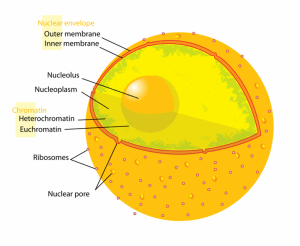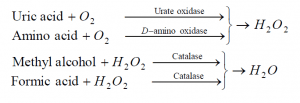Microbodies: Glyoxysomes, Peroxisomes & Sphaerosomes
Introduction
Microbodies are single-membrane bound small spherical or oval organelles that take part in oxidation reactions other than respiration reactions. They can only be seen with an electron microscope. Microbodies have a crystalline core and granule matrix. These are the following types:
(1) Glyoxysomes
(i) Discovery : These were discovered by Beevers in 1961 and Briedenbach in 1967.
(ii) Occurrence : These are found in fungi, some protists and germinating seeds, especially in germinating fatty seeds, where insoluble lipid food reserves must be converted into soluble sugars. Animals can not perform this conversion because they do not have glyoxylate enzymes.
(iii) Shape, size and structure : They are spherical in shape, about 0.5-1 μm in size, they contain glycolic acid metabolism enzymes through the glyoxylate cycle and bound by a membrane unit. They also contain enzymes for the β-oxidation of fatty acids.
(iv) Functions : The main function of glyoxysomes is conversion of fats into carbohydrates.
(2) Peroxisomes (Uricosomes)
(i) Discovery :These were discovered for the first time by J. Rhodin (1954) in the mouse kidney cells, with the help of an electron microscope, was called a microbodies. De Duve (1965) isolated certain bags such as organelles from different kinds of animals and plants. They were called peroxisomes because they contain enzyme-producing peroxide (oxidases) and enzyme-degrading peroxide (catalases).
(ii) Occurrence :These are found in plant photosynthetic cells. Peroxisomes are abundant in the liver and kidney cells of vertebrates in animals. They are also found in other organs such as the brain, small intestine, testis, and adrenal cortex. They also occur in invertebrates and protozoans such as Paramecium.

(iii) Shape, size and structure :They are spherical in shape, about 1.5 μm in size. They are bound by a single unit membrane. They contain granular consents condensing in the centre. Its membrane is permeable to amino acids, uric acids, etc. They contain four H2O2 metabolism enzymes. Enzymes urate oxidase, d-amino oxidase, a-hydroxy acid oxidase produce H2O2, while catalases play a significant protective role because H2O2 is toxic to cells.

(v) Function :They are involved in the formation and degradation of H2O2. Plant peroxisomes are also involved in photorespiration. In which the glycolic acid oxidase enzyme oxidises glycolic acid to glyoxylic acid. In the case of plants, peroxisomes are also known as glyoxisomes.
(3) Sphaerosomes
(i) Discovery : These were first observed by Hanstein (1880) but discovered by Perner (1953). Term sphaerosomes was given by Dangeard.
(ii) Occurrence :These are found in all plant cells involved in lipid synthesis and storage, i.e. endosperm and cotyledon.
(iii) Shape, size and structure :They are spherical or oval in shape about 0.5-2.5 μm in diameter. They contain hydrolytic enzymes such as protease, ribonuclease, phosphatase, esterase, etc. They are bound by a single unit membrane.
(iv) Function : The main function of sphaerosomes is to help in lipid metabolism. They are also known as plant lysosomes.
